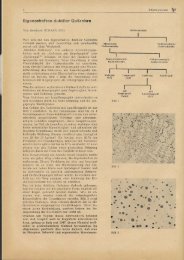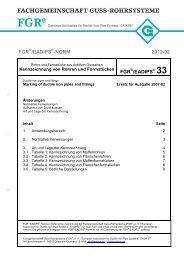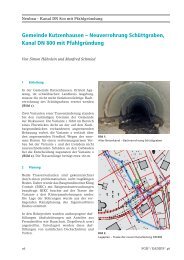Download PDF file
Download PDF file
Download PDF file
- TAGS
- download
- 81.169.135.155
You also want an ePaper? Increase the reach of your titles
YUMPU automatically turns print PDFs into web optimized ePapers that Google loves.
Fig. 4:<br />
DN 700 HDD – Plan of locations and heights<br />
2 The problems and how they were solved<br />
With all the requirements and constraints<br />
described, installation in open trenches could<br />
be dismissed straightaway. The old pipeline<br />
could not be replaced during operation, but<br />
operation needed to be maintained. Because of<br />
the restricted access routes, pipes of any great<br />
length were not an option and short assembly<br />
times were wanted. Laying out a string of pipes<br />
would have hampered access and consent had<br />
not been given for the pipeline to be floated out<br />
on the river.<br />
The experience which Berliner Wasserbetriebe<br />
had already had with ductile iron pipes on previous<br />
sections had been good. The relatively<br />
short laying lengths of 6 m were found to be an<br />
advantage on these. Angular deflections of the<br />
restrained joints would allow flexible adjustments<br />
to be made to cater for fixed points along<br />
the route.<br />
The horizontal direction drilling (HDD) technique<br />
was an elegant way of meeting these different<br />
requirements. After a critical check on<br />
60<br />
the costs, the consulting engineers doing the<br />
planning, Hyder Consulting GmbH Deutschland,<br />
also considered it the preferred technique.<br />
Experience with projects of a similar size<br />
abroad meant that there was even less of a risk.<br />
3 Preparations for installation<br />
Berliner Wasserbetriebe’s project management<br />
department did the planning and took conscientious<br />
account of the interests and demands of all<br />
the parties involved and affected. A restricted<br />
invitation to tender with an open competitive<br />
pre-qualification procedure then selected<br />
the consortium to do the installation work and<br />
a further invitation to tender decided the pipe<br />
and fittings supplier.<br />
An order was placed for 504 m of ductile iron<br />
pipes to EN 545 [1] of wall-thickness class K 9<br />
with TYTON® push-in sockets and the BLS®-/<br />
VRS®-T restraint system and for the fittings<br />
required. The pipes are lined with cement<br />
mortar and on the outside are zinc coated<br />
with a rugged outer cement mortar coating to<br />
FGR® / EADIPS® 46
















